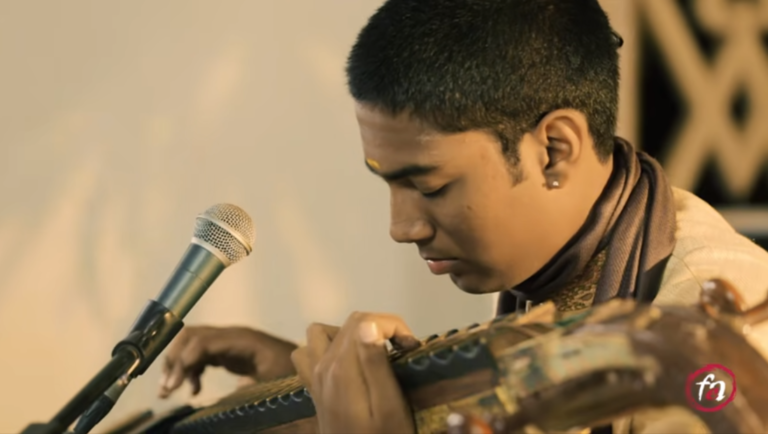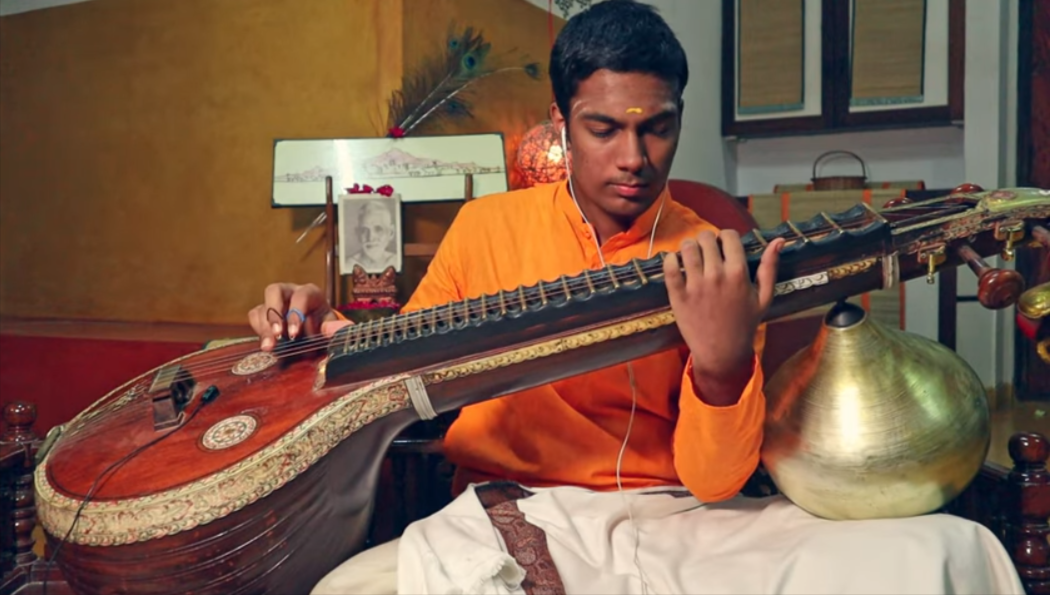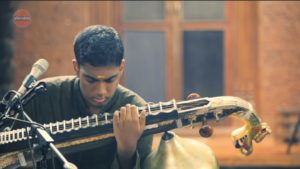Interviews
- Interviewed by Saamagana Melody magazine, Bangalore in May 2018
- Interviewed for Advantage Karnataka, a government magazine in July 2018
- AIR, Bangalore aired an interview with Ramana (along with his concert)
Articles
- Oct 27th, 2014: Times of India featured Ramana in the article “Child prodigies make Bangalore proud”
- Feb 2015: Sruti magazine carried a cover photo of Ramana with a review of his Veena concert in the Chennai Music Season, 2014
- Dec 2015: Voted one of the 10 young musicians to look for at http://ahummingheart.com/10-young-carnatic-musicians-to-look-out-for/
- Mar 24th, 2016: Article titled “Child prodigy to receive Prof G T Narayana Rao Award” in Star of Mysore
- Mar 27th, 2016: “Vid Ramana Balachandran conferred Prof G. T. Narayana Rao Award” in Star of Mysore
- June 6, 2016: AIR, Bangalore called out Ramana as an exceptional talent and explained how AIR, New Delhi granted a special age waiver – in the interview to The Hindu – article titled “The attraction of AIR grades for artistes”
- http://srutimag.blogspot.in/2017/12/ramana-balachandhran.html – Sruti magazine’s interview of Ramana (December 2017)
- Article in Mint: http://www.livemint.com/Leisure/oa8LYCxvv6140d53015NpN/The-making -of-a musical-prodigy.html
- Deccan Herald video profile at https://www.deccanherald.com/video/karnataka/dhchangemakers-ramanab
alachandhran-793517.html - Deccan Herald 2020 change-makers article at https://20in20.deccanherald.com/ramana-balachandran
- Speaking through the strings of Veena – coverage by Advantage Karnataka, a state government publication https://www.advantagekarnataka.in/fullnews.php?categoryname=Infotainment%20news&categoryid=164
concert reviews
“Playing the veena, a type of South Indian lute that to my untrained senses looks and sounds like a slightly smaller version of a sitar, he displays a phenomenal virtuosity far beyond his tender years, and the creativity is breathtaking.”
XIV: (October, 2022, Morning Star, London - excerpts from review)
“A vocal touch to the veena”
Bengaluru-based Ramana Balachandran, 18, who had learnt to identify ragas as a toddler and had claimed in an interview that the veena chose him (and not the other way round), came down to Hyderabad for an instrumental concert organised by Sri Karthikeya Gana Sabha recently. The weekend evening was proof of how well he has blossomed into a skilful instrumentalist over the years (he plays the mridangam too)…. Commencing most of his concerts by offering the audience a flavour of the vaggeyakara’s sahitya through the pallavi, he gradually progresses towards the instrumental segment and makes a surprise return to the lyrical element in a later charanam almost effortlessly. The vocal and instrumental segments seamlessly segued with his opening number, Thyagaraja’s Ninne Bhajana in Nata ragam. The many gamakas and the imaginative swarakalpana in the higher tempo gave the rendition a flourish in a ragam that is conventionally touched upon at the beginning of a concert…. His next choice was Challare Ramachandruni in Ahiri ragam. Known to evoke the karuna rasa and believed to be one of the most difficult ragas to render on a veena, Ramana displayed impressive restraint in exploring the several contours of Ahiri. The textured composition received its due on the instrument and the youngster followed it up with an assured performance of another challenging kriti Sri Narada Naada . The pensively styled composition with varying scales is always a firm test of skill for a musician. The swara delineation proved that the ornamental, gamaka-driven Kanada ragam is best savoured on the veena….Among the many masterpieces that Balamuralikrishna has composed, Meenakshi Jayada in Hamsanandi is certainly a jewel in his crown. The ease with which the young musician balanced the veena, singing the complex charanams addressing Goddess Durga and was supported by the mridangam artiste Raghavan Sai, resulted in a compelling output that served a timely reminder of the composer’s musical genius. The majesticity of a Ghana ragam like Bhairavi was elaborated at length in Ramana’s ragalapana before presenting Thyagaraja’s Raksha Bettare . The neraval and manodharma at Sangeethapriya sustained the musician’s fine momentum….In times when RTP rarely makes it to vocal concerts beyond the annual music festivals, it was a welcome surprise to watch Ramana take up the hummable, melodic Brindavana Sarangi ragam as the main item. Gurunatha Aruna Gurunatha Ramana Karuna Satchidananda was his choice of lyrics for the pallavi segment. The charm of the ragam comes from its glides and subtle modulation, which Ramana successfully elicited in multiple tempos….Rendering one of Nedunuri Krishnamurthy’s most complex compositions among the Ramadasu kirtanas, Emayya Rama in Kambhoji ragam, the musician had proved that he was prepared to take the rough road ahead. Though a few madhyama kala kritis would have made the concert livelier and could’ve provided momentary relief to the musician too, the youngster’s courageous choices showed he belonged to a different breed….
XIII: (March 6th, 2020, The Hindu - excerpts from review)
“Ramana Balachandran brought alive the veena-vocal link”
“To experience Ramana Balachandran’s veena music is to reconnect with the age old veena-vocal link that has made the instrument an extension of voice. At his recital for the Crossroads concert series, curated by First Edition Arts, at the R.R. Sabha mini hall, the artiste, accompanied by mridanga vidwan Patri Satish Kumar, set out to prove that this inherited tradition was alive and well……………………. ….Singing along as he played the opening lines of kriti, Ramana began with ‘Ennado Rakshinchithe’ Tyagaraja (Saurashtram), deeply oscillated gamakas lent weight to the sangatis. Swarakalpana gained texture from odukkal permutations. …………………..The conventional opening strains of Ranjani gave little inkling of the rain of creative expression that was to follow. This was not the standard essay built brick by brick in phased blocks. Rather, instinct led the way as the artiste surrendered to the moment. Vibrant sancharas looped across a 2-octave gamut, illuminated by flashes of insight and finessed by kuzhaivus from and to the madhya sthayi dhaivatam. Cached around almost every bend were surprises — welcome ones. ‘Dattatreya Trimurti Roopa’ (Ganapathy Sachinanda Swamigal) touched several highs in melodic sangati mapping…..An interestingly structured chittaiswaram and kalpanaswara rounds that guided the concluding exchange to touch home plate with a spot-on porutham, opened up avenues of discovery for artiste and rasikas alike. En route, reflective alfresco clusters gave way to deep, resonant undertones generated in the mandra sthayi.…………….……….The inherent tranquillity of Sankarabharanam spread its balm in the wake of mandra and madhya sthayi passages. Meditative at the gandhara, springboarding at the panchama and softening to a muted glow at the tara sthayi shadja, the main alapana’s trajectory rode the wave of a predominantly madhyamakala exposition. At the tara sthayi gandhara, you listened to magic
unfurl………………………..A seamless segue into a gradually accelerating tanam wove together a homogeneous entity brimming with bhava, crowned by a lustrous ‘Emi Neramu’ (Tyagaraja) that dove deep into the raga to emerge with precious nuggets. After a few organically evolving rounds of melkala and kizhkala swaras, the action was centred at the kuraippu at the gandhara that threw up a slew of challenging rhythmic patterns……………………….Rooted in substance, the gravitas and bhava in Ramana’s playing was expressive to the point of being vocal with an emotive intensity that captivated cognoscenti and lay listeners alike.
XII: (November 22nd, 2018, The Hindu – excerpts from review)
“An Emerging Veena Star”
“…Ramana’s Veena technique can be termed “Gayaki” style, with emphasis on the nuances of vocalized music. Ramana’s approach is steeped in gamaka oriented music. Even for the brigas, Ramana seemed to eschew split fingering in favor of producing them on a single fret. Ramana is innovative in the true sense of the word – he pushes the creative boundaries, while staying true to the idioms of the music; his alapanas are refreshingly free flowing; he is clearly charting new waters with his swara prastharas, trying out new patterns and poruttams (fitted patterns); his choices of krithis show his keen aesthetics.
XI: (June 2nd, 2018, Sruti Magazine - USA edition)
“Stepping back to mediate”
“….Ramana’s Varali was a compelling ebb and flow of sumptuousness and Spartanness, robustness and delicacy. Deep oscillations, silken jarus and shadja varja passages spun a mesmeric web. Take for instance, the prolonged, firmly held, meditative tara sthayi rishabha fading to a just-articulated shadja — a sublime moment….”
X: (August 17th, 2017, The Hindu – excerpts from review)
“Unobtrusive plucking, Adherence to traditionalism”
“Young Ramana Balachandhran gave a brilliant veena recital under the aegis of Sri Nadabhrama Sangeetha Sabha on Nov 19 … It is a sight to see him perform on his 45 years old traditional Veena, singing in between while he plays. Right from the Surutti varna, he maintained a standard and the vocal quality that never flinched….The alapana of Abheri was amazing and Swaras to ‘Bhajare Manasa Sri Raghuveeram brimmed with raga bhava. ‘Sri Rama Jaya Rama Shringara Rama’ reflected the beseeching tone of the composer. The boy singing the composition proved his dedication to the composition and the composer … Shankarabharana, the main raga of the evening was well embellished with a bhava-laden alapana … ‘Sura Munigalu Tamma’ was chosen for neraval beautified with spontaneous swaras…The concert also included an RTP in Kapi, set to Khanda Triputa Tala, Trishra nade. The pallavi was unique. While the raga alapana of Kapi embodied the special usages and its diverse shades, the pallavi “Pibare Ramana Rasam Janana Marana Shoka Vidooram” was a reaffirmation of Ramana’s grip over the laya and over the instrument ….”
IX: (December 5th, 2016, STAR of Mysore – excerpts from review)
Young Ramana Balachandran of Bengaluru is a fine budding Veena player with immense potential. He has already mastered the divine instrument with utter devotion that unravels in his playing. The accurate placing of fingers to produce the right note and the gayaki style of playing which brings rich raga bhava are the hallmark of his playing. The plucking of the strings is according to the sahitya or the lyrics that enhances the musical experience. Knowledge of vocal music and mridanga has immensely helped him in bringing the sahityabhava and a perfect layajnana. Ramana Balachandran was accompanied by Tumkur Ravishankar (mridanga) and Sharath Kaushik (ghata).
He opted to play only a few compositions, stressing on the manodharma sangeetha that enabled him to showcase his rich imagination. The opening few phrases revealed the raga Mayamalavagowla and paved way to ‘Tulasidala,’ the fine composition of Saint Tyagaraja.
The perfect Kalpanaswaras that followed revealed his matured manodharma. The unerring fingers moved swiftly with accuracy. A masterful exposition of raga Ranjani did ample of justice to the composition of Ganapathy Sachchidananda Swamiji’s ‘Dattatreya Trimurthyroopa.’ The same mood prevailed throughout the concert, with no gimmicks of any sort.
The pure Classicism in his playing breathes hope. He can bring in the right tempo or gati according to the Kruthi for an effective exposition. As a consequence, the raga and the Kruthis were lyrical and provided an all-round satisfaction. Shyama Shastri’s ever green Kruthi ‘Maayammayani ne’ (Aahiri) and Tyagaraja’s‘ Tulasamma’ (Devagandhari) were a feast to ears. Ramana’s control on the speed was praise worthy. Natakapriya and Kambodhi were in the forefront in the concert with a very pleasing and elaborate exposition underlining both the melody and the mood. TanjavurShankarayya’s ‘Geethavadyanatananaatakapriye’ and Tyagaraja’s ‘Maajaanakeesha’ were filled with raga bhava. A brilliant taana too adorned Kambodhi.
He would burst to singing sometimes indicating his involvement. A cascade of kalpanaswaras were enjoyable. Tumkur Ravishankar and Sharath Kaushik’s percussive support was a plus point. Ramana Balachandran rounded off with a Devaranama of Sheshagiri Achar. His future is undoubtedly worth watching.
VIII: (July 17th, STAR of Mysore – excerpts from review)
Bharatiya Vidya Bhavan and the Infosys Foundation in association with MES Kalavedi and Ananya presented veena and vocal concerts under the ‘Outreach Cultural Programme’ series […..] Fourteen-year-old Ramana Balachandran is a child prodigy [….] Ramana caught the attention of connoissieurs right from ‘Sachidananda’, an infrequent varna in the raga Bhegade. It was followed by a keerthana in Dharmavathi. But the piece de resistance was the well-known composition of Saint Tyagaraja ‘Ea Vasudha Neevanti’. Earlier Shahana alapana blossomed with good ‘ragabhava’ sans gimmicks. Thana was brief but brisk and sparkling. He concluded his fine concert with the famous thillana in jinjoti. No doubt, Ramana Balachandran has a bright future in the years to come […..]
VII: (Dec 28th, Deccan Herald, Bangalore edition – excerpts from review)
[……] Though we have many child prodigies in the field of music like U. Srinivas & Mysore Manjunath, this lad awed the audience with his talent. Gayaki style is akin to singing on veena. It is playing on the veena whatever the voice can sing. Veena Dhanammal, S. Balachander and Jayanti Kumaresh belong to this category. Gracefulness of the nada, replicating vocal music and the dynamics of a voice (the pronunciation) and accent on each syllable of the sahitya, elaborate raga alapana replete with gamaka and leisurely pace were the prominent features of Ramana’s concert. Ramana established his skill in the very first composition ‘Sri Mahaganapatim Bhajeham’ in Athana of the Mysore Maharaja Sri Jayachamarajendra Wadiyar. The audience were spellbound to see him develop the raga Todi with such wonderful imagination and spontaneity, without compromising on classicism. Thyagaraja’s ‘Dasharathe’ was so beautifully presented in vocal style that one could almost hear the sahitya in the playing [……]
VI: (Dec 16th, Star of Mysore, Mysore edition – excerpts from review)
A finely nuanced rendition of Shyama Shastri’s “Mayamma” in Ahiri, brimming with raga bhava and reflecting the beseeching tone of the lyrics followed. The complex vivadi scale of Sruthiranjini was handled with great finesse and imbued with softness in the ensuing brief elaboration, suffixed with the Thyagaraja krithi ‘Edari Sancharinthura’ in adi thala and some fluid kalpana swaras.
Anandabhairavi was taken up for a fairly detailed alapana that enshrined the gamaka-laden beauty of the raga, the gradual progression upwards punctuated with symmetrical and consonant phrases integral to its identity. Thyagaraja’s ‘Neeke Theliyaka’ in adi thala was supplemented with kalpana swaras in two speeds that mirrored the melodic essence of the raga.
Considerable manodharma skills were explicit in the detailed exposition of Poorvikalyani, one of the highlights of the concert. A plethora of sancharas at each of the pivotal notes such as the gandhara, panchama and the thara sthayi shadja, and in the lower and higher octaves attested as well to admirable dexterity and a keen aesthetic sense [….]
The concert also incorporated a raga thana pallavi in Surutti set to tishra jathi ata thala, with the laghus in tishra gathi and the druthas in chathurashra gathi. While the compact, yet exquisite alapana embodied the sweet classicism of the raga, its special usages and its diverse shades, the thana wove a tapestry of intermeshed lilting patterns.
The pallavi, which also included the mandatory tempo variations and short ragamalika kalpana swaras in Chandrakauns and Kanada, was a reaffirmation of a firm grip over laya, the idiom and the instrument [….]
The presentation was remarkable for the expertise, spontaneity and equanimity of the main instrumentalist, rarely seen in one so young. Several of the songs were introduced vocally along with the sahithya, the veena taking over thereafter and infusing them with an old world charm and attesting to familiarity with the lyrics.
Adherence to the dictates of classicism, fidelity to the traditional contours of ragas such as Ahiri and Anandabhairavi, unobtrusive plucking, the fine tonal quality and deft modulation displayed in the recital, augur well for the development of the young artiste into a consummate performer.”
V: (July 30th, The Hindu, Bangalore edition – excerpts from review)
“As part of the 67 Sri Ramanavami Music Festival organised by Sri Sheshadripuram Rama Seva Samithi, head bent over his veena, Ramana’s meek figure was hardly noticeable as one looked at the stage, especially when giant portraits of Rama loomed in the background. However, as he struck the first note of ‘Sri Ganapatini Sevimparare,’ one realised that the unassuming, shy persona nurtured a humble artist of extraordinary caliber inside [….]”
IV: (April 9th, The Hindu, Bangalore edition – excerpts from review)
“A promising vainika in the making, Master Ramana Balachandran, barely 13, made a great impression through his concert at the Tattvaloka auditorium. He has a sweet and melodious touch, strength in laya and can sing, too [….] Such is his touch that even his scale-based phrases sound melodious [….] He played Tsallare (Ahiri, Tyagaraja); daring, indeed for his age but bhava seems to be ingrained in him.
There were many exhilarating moments in his alapana of Kedaragauala, too [….] He learns the veena, vocal and mridangam formally and resorts to home-schooling for the regular academic stuff! May his tribe grow in numbers and may we sow the seeds for a new generation that can pursue its own interests and not its parents.”
III: (February, 2015, Sruti Magazine – excerpts from review)
“Maanikya Veena Upalaalayanteem” ….thus begins the great stotra by Mahakavi Kalidasa, in which he describes Goddess Saraswathi as the one playing the Veena made of emerald [.…] and if one was yearning for a personification of this stotra, it happened on the evening 13th September 2014 at Ranjani Fine Arts. This time it was the child prodigy Shri Ramana Balachandran holding the Veena [….] And then the magic began […..] Ramana started with the Thodi Varnam ‘Eranapai’ composed by Shri Patnam Subramania Iyer. He sang the varnam in different speeds including Tisram and quite instantly, the melody he created started captivating the audience…..Here was a Veena performance of the highest
order and hence this rare RTP was more than welcome […..] Minutes of divine magic unfolded. The audience was taken into a different world, as everyone was literally glued to their seat. This young child’s Vidwat came forth yet again as he converted the Raga into an ocean of divine sounds […..] More than 120 minutes of heavenly music and the audience were left speechless…..Ramana himself with the Maanikya Veena – one can’t help summarizing with the Shyaamala Dandakam: Maanikya Veena Upalaalayanteem (One who plays a Veena of emerald)Madaalasaaam Manjulavagvilaasaam….(One who is busy with activity, One who can talk honeyed words,…”)”
II: “Ramana – Ananda Ramana”
“A packed house at SRLKM witnessed a wonderful Veena concert by Sri Ramana Balachandra. It was hard to imagine that this nice a Naada can emanate from a boy so young [.…] He seems to follow the Gayaki style of Veena playing [….] A majestic Thodi, a Raga that is normally not elaborated on the Veena for fear of the innumerable gamakas was handled by Ramana with great ease and poise [.…] After a very encouraging speech by Sri G.V Krishnaprasad where he urged all the Sabhas to take notice of a prodigious talent like this, Ramana concluded his concert with concert with Baro Krishnayya and Sri Lalgudi Jayaraman’s Yamuna Kalyani Tillana. The full house at the venue and the number of people watching the webcast of the concert on live.shaale.com bore testimony to the fact that a good Veena concert does have many takers. Those of
you who missed it please make sure you watch the concert at http://new.livestream.com/shaalelive/06apr2014”.




